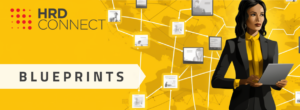Mitigating HR Risk
- 5 Min Read
Talent is our greatest asset as HR professionals. How can our data help us to manage the many risks involved? Brad Winsor, VP of People Analytics, SplashHR, examines the role of data in mitigating HR risk.
- Author: Brad Winsor
- Date published: Feb 20, 2020
- Categories

Risk is everywhere. Legal risk, market risk, and supply chain risk are an everyday occurrence in business. Financial risk is so prevalent that it’s spawned an industry to mitigate it. I took a small risk driving to work today.
In HR, we have a healthy supply of risk. Legal and compliance risks are commonplace – we’ve gotten pretty good at managing these risks. However, there’s a risk that keeps top HR leadership up at night:
Failure to supply talent to drive the business.
For most organizations, talent is our greatest asset. It’s what separates us from the competition and makes our organizations unique. If we fail to provide the right human capital, the business suffers or fails.
Providing talent is HR’s most critical function and is our biggest risk.
Talent is a volatile asset. Unlike widgets in a warehouse or money in the bank, talent comes and goes at it pleases. And unlike widgets and money, human capital has moods and human expectations.
So how do we manage talent risk?
It’s like managing any other type of risk:
- Assess risk of losing key resources
- Discover loss drivers
- Mitigate
The first step is a challenge for most. We don’t really know who is at risk of exit. We have a lot of historical information about our employees, but we don’t know what they’re going to do tomorrow or next month.
Some organizations ask managers to identify which of their employees are at risk of exit. While this is a good thing, most organizations only collect this subjective data once a year. These assessments allow little time for intervention and are highly subjective.
Our data holds the answers. We’re just not wearing the right glasses.
For an objective and more granular assessment of talent risk, we use data and statistical models.
We have a ton of HR data. Virtually every aspect of the employee experience is managed by technology. These systems make our lives easier, and they also remember our employee stories.
Collectively, the employee experience holds answers about loss risk. We learn from what people did in the past to predict what they’re likely to do in the present and near future. Using this data, the machine learns what things drive exits and what things people tend to do before quitting.
A driver is something you can typically control, such as compensation or learning spend. A factor is an attribute of an employee, such as education level or commute time to the office. Indicators are things that precede exits, such as a change in absenteeism or a change in education level.
Examples:
Drivers
- Pay quartile
- Talent mobility
- Telecommute / flex time
- Retention spend
- Development spend
- PTO allowance
- Manager team size
- Manager development spend
Factors
- Commute time to the office
- Experience level
- Previous employer
- Tenure with previous employer
- Education level
- Competencies
Indicators
- Absenteeism
- Benefits participation
- Health & wellness participation
- Change in distance from the office
- Change in education level
- Development participation
We provide these data points to an AI routine, which gradually learns from them to discover what factors and actions drove past exits.
When applied to the current workforce, the machine learning can predict the likelihood of each employee exiting. We combine this with core HCM data to learn about the impact of the risk.
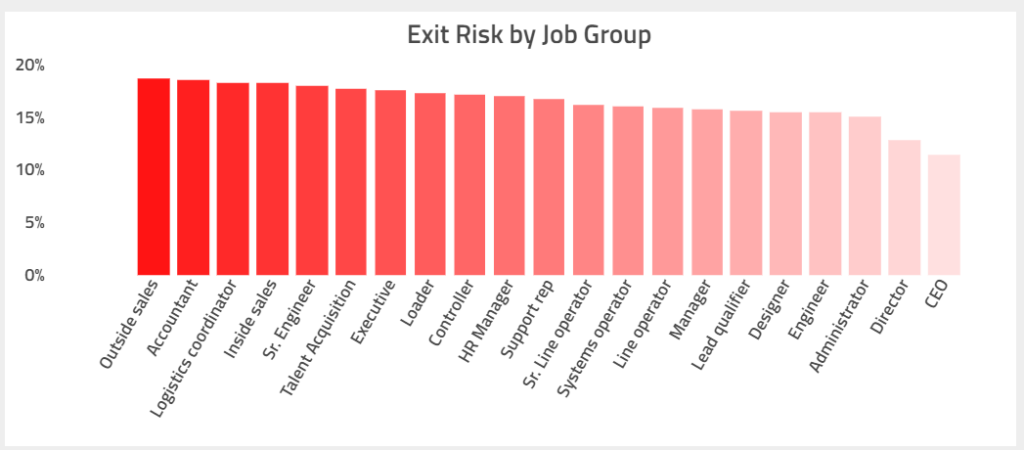
The above chart shows us what types of jobs face the highest loss risk.
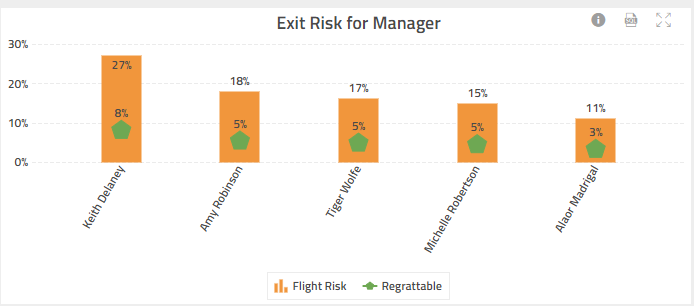
Here, we see which leaders face the highest talent risk.
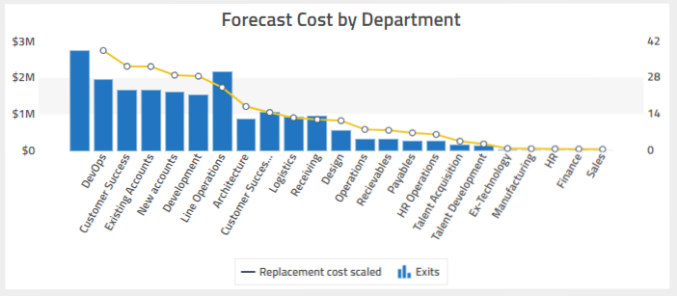
The graph above shows predicted loss impact for each department.
We know how many exits each department is forecast to incur and how much it will cost to replace these employees.
Now that we understand the extent of our risk, it’s time to intervene. For this, we look at the causes of predicted talent risk.
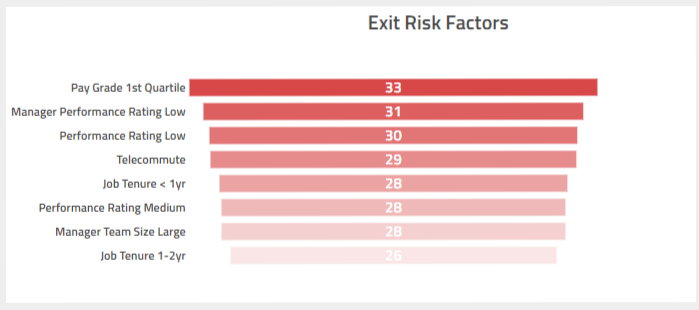
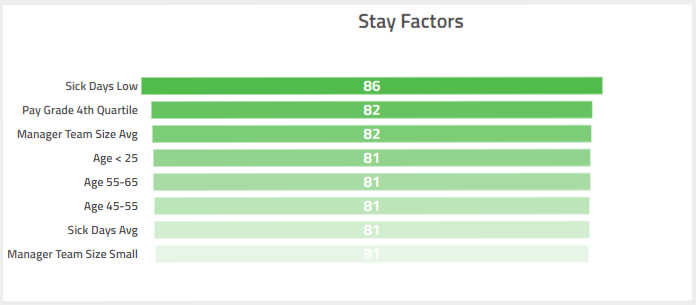
The charts above tell us why employees are likely to quit and why they’re likely to stay. This is the information we need to take action to mitigate risk.
Making sense of the results
From a quick review of the factors, we can draw some findings:
- Compensation is a significant exit driver for employees in the bottom pay quartile
- Low performing managers drive exits
- Managers with large spans of control face high exit risk
- Sick time usage directly correlates to exit risk
From this brief look at the findings, we have a good idea of how to mitigate our talent risk.
In this instance, my first action would be to review compensation for all high-performing employees who are in the bottom pay quartile.
I would also plan coaching for under-performing leaders. Our data shows that employees are, indeed, leaving struggling managers.
In conclusion
This was a brief look at how people data and machine learning help us mitigate workforce risk, by understanding who is at risk of exit and why we can mitigate talent risk.
Employee exit risk is just one of a host of predictive analytics at our disposal. People analytics can:
- Identify employees with high promotion potential
- Identify potential top performers
- Find leaders with the most (and least) talent mobility
- Pick candidates most likely to be top performers
- Predict headcount supply and demand
- Suggest career paths
- Recommend training to fill skill gaps
The secret is to use our data – all of it. When we connect the dots of our employee stories, a bigger picture comes into view.


